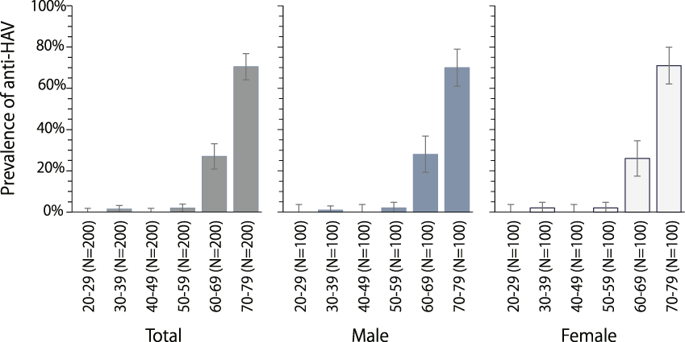Scientific Reports ( IF 3.8 ) Pub Date : 2019-02-06 , DOI: 10.1038/s41598-018-37349-1 Chikako Yamamoto 1 , Ko Ko 1 , Shintaro Nagashima 1 , Takayuki Harakawa 2 , Toshiko Fujii 1, 2 , Masayuki Ohisa 1 , Keiko Katayama 1 , Kazuaki Takahashi 1, 3 , Hiroaki Okamoto 4 , Junko Tanaka 1

|
Since the early 21st century, almost all developed countries have had a very low hepatitis A virus antibody (anti-HAV) sero-prevalence profile, as sanitation conditions and health care facilities have been optimized to a universal standard. There has not been a report on anti-HAV prevalence among a large scale population in Japan since 2003. Therefore, this study aimed to investigate the current HAV status among the general population in Hiroshima. From each age and sex specific group, a total of 1,200 samples were randomly selected from 7,682 stocked serum samples from residents’ and employees’ annual health check-ups during 2013–2015. Total anti-HAV was detected using Chemiluminescent Enzyme Immunoassay. The overall anti-HAV sero-prevalence was 16.8%. In both males and females, anti-HAV prevalence among individuals between 20–59 years of age was as low as 0.0–2.0%, whilst that among 70 s was as high as 70.0–71.0%. A large number of residents aged under 60 are now susceptible to HAV infection. The cohort reduction trend of anti-HAV in Japan exposes the high possibility of mass outbreak in the future. HAV vaccine especially to younger generation and high risk population may prevent outbreak in Japan.
中文翻译:

在日本,抗HAV的患病率很低:未来爆发的可能性很大。
由于早期的21日一个世纪以来,几乎所有发达国家的环卫条件和卫生保健设施均已达到通用标准,因此其甲型肝炎病毒抗体(anti-HAV)血清感染率很低。自2003年以来,日本尚未有关于大规模人群中抗HAV流行的报道。因此,本研究旨在调查广岛普通人群中当前的HAV状况。在2013-2015年期间,从每个年龄和性别的特定人群中,从居民和员工的年度健康检查的7682份血清样本中随机选择了1200个样本。使用化学发光酶免疫测定法检测总的抗HAV。总体抗HAV血清感染率为16.8%。在男性和女性中,20-59岁之间的人群中抗HAV患病率均低至0.0-2.0%,而在70 s中,这一比例高达70.0–71.0%。现在,许多60岁以下的居民容易感染HAV。日本抗-HAV人群减少的趋势暴露了未来大规模爆发的可能性。特别是针对年轻人和高危人群的HAV疫苗可以预防日本的爆发。

































 京公网安备 11010802027423号
京公网安备 11010802027423号